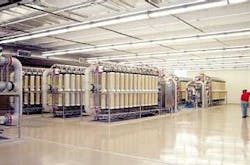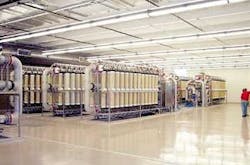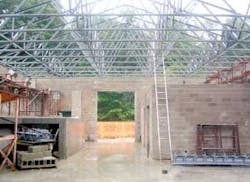Practical Issues of Ownership of a Membrane Plant
By Simon Dukes, Benjamin Antrim and John McArdle
In the last 10 years, membrane systems have grown in use for production of drinking water and treatment of wastewater for removal suspended solids, bacteria and viruses. In the last few years there has been a move to install membrane systems as tertiary polishing operations, for example in the New York City Watershed wastewater plants as part of the Watershed Protection scheme.
Membrane systems have several operating characteristics that are different from conventional plants, such as response to changing feedwater conditions and flow maintenance. An appreciation of these differences is important for smooth startup and operation of the plant. There are also aspects of operation that are unique to membrane plants, such as monitoring and maintenance of integrity and periodic chemical cleaning.
Membrane Types
Membranes are commonly divided up into four broad categories based on pore size and rejection criteria. These are Microfiltration (MF), Ultrafiltration (UF), Nanofiltration (NF) and Reverse Osmosis (RO). MF and UF are used for particle filtration applications.
MF and UF membranes physically retain particles based on size difference between the pores and the particles to be removed. Many configurations for MF and UF are available, but for municipal applications where a barrier to bacteria is needed, hollow fiber membranes are used almost exclusively. Both MF and UF can typically achieve more than 4-log removal of bacteria. UF will actively filter viruses and is typically accredited with a 4-log reduction. MF typically achieves 0 to 0.5-log removal of virus due to the larger pore size.
Turbidity removal is generally excellent in integral membrane systems. Irrespective of the feed turbidity, the filtrate turbidity will be less than 0.1 NTU.
Feedwater Chemistry
An understanding of the feedwater chemistry is important for smooth operation of a membrane plant. Anything that is soluble in the feedwater will be passed by MF or UF. If a soluble substance post-precipitates in the filtrate, this can increase the filtrate turbidity and cause membrane fouling if the filtrate is used as part of the membrane cleaning process. This can occur due to insufficient time being allowed for any chemical reactions to go to completion, or due to changes in the filtrate chemistry because of pH adjustment or chlorine addition.
Flux Maintenance
All membranes are subject to fouling, which has the result of increasing the pressure required to drive water through the membrane (transmembrane pressure). There are two main types of fouling, surface fouling and adsorption. Surface fouling occurs when material physically is deposited on the membrane and builds up. Adsorption fouling occurs when chemical species present in the feedwater chemically attach to the membrane material. Mechanical and chemically assisted techniques are available for recovering from both of these types of fouling.
Mechanical Means
All membrane systems use mechanical means to maintain flux. This takes the form of backflush, a process whereby water and/or air is forced backwards through the membrane, thereby disrupting the surface fouling layer and removing the surface fouling from the system. The backflush is often followed by a Fast Flush, where feedwater is allowed to freely flow past the membrane surface without filtration to remove solids from the membrane system.
Chemical Means
Chemicals are sometimes introduced during the backflush to remove adsorption fouling by acting on material that is directly adsorbed on the membrane surface. The particular chemical or combination of chemicals that is used will vary according to the membrane and the type of fouling. All the chemicals must be flushed from the system prior to resuming production.
There is a tradeoff between the operating pressure and the amount of chemicals that are used. In some cases, plants minimize chemicals and operate at higher pressure for ease of operation and to reduce disposal costs. In other cases, plants use more chemicals to minimize operating pressure and save energy.
System Configurations
Hollow fiber membranes are available in inside-out and outside-in configurations. Inside-out membranes have the raw water on the inside of the fiber and filter to the outside. Outside-in membranes have the raw water on the outside of the fiber and filter to the inside. Systems can be pressure- or vacuum-driven. Different system configurations and membrane materials have different strengths and weaknesses. The various system suppliers have developed appropriate operating and cleaning techniques so that, regardless of system configuration, the systems can work well.
All of the systems can be disturbed by changes in process feed conditions, which require the operator to take steps to modify plant operation. The pressure range is important because this provides the "headroom" for short term upsets before the process starts to lose flow. For this reason, a pressurized system is often preferred since it provides a wider pressure range and more operational flexibility.
System Integrity
System integrity is important because only integral membranes give the required level of filtration, and also most membrane systems use filtrate to backflush. If filtrate has particles in it, it can lead to fouling on the permeate side of the membrane. The system integrity is the measurement of the barrier between the feed side and the product side. The only connection from feed to product should be through the intact membrane. Typically systems use a combination of direct and indirect methods of measuring system integrity to ensure a properly functioning plant.
Most system manufacturers have methods for repairing fibers if necessary. All plants will experience fiber breakage to some degree, and membrane life time is often measured by the number of fiber repairs in a cartridge. It is important to keep track of the rate of breakage, which is often indicative of some mechanical problem with the plant.
Chemical Cleaning
Chemical cleaning is typically performed when the transmembrane pressure of a membrane plant approaches the design maximum. This is usually due to an accumulation of fouling material that the regular flux maintenance regime is unable to remove. Often this is a routine cleaning step, but in periods of upset, may also be an emergency measure. Upsets can occur for many reasons such as abrupt seasonal changes in surface water quality or response to weather events.
Fouling can take many forms, and is often a complex issue. This usually requires several different approaches with cleaning chemicals. Often a single cleaning will use a caustic and oxidant mixture to remove organics, followed by an acid to remove inorganic foulants. The chemicals used and the order in which they are used is dependent on the particular water source and the nature of the fouling. There are times when the standard chemical cleanings will not restore flux, and at these times it is often advisable to obtain support from the system supplier. Some suppliers have extensive expertise in cleaning unusual and difficult substances off the membranes.
Maintenance
Poor mechanical maintenance of a membrane plant is one of the prime reasons for premature membrane failure. The stresses that a membrane module is exposed to can be significant, especially during the frequent transitions from production to backflush. A problem in the movement of a valve actuator or the action of a pump can be a major source of stress for the membrane. Plant operators need to be familiar with the normal operation of their plants and take prompt action if any change is experienced. This is especially the case with sticking valves and actuators.
A well understood SCADA system is a powerful tool in identifying operational problems, and a membrane system supplier often offers a service to remotely interrogate the plant to assist the operator in troubleshooting. Glitches in programming can occur as a result of incidents such as local lightning strikes. These can often be resolved without the need for a site visit if remote access is possible. A good inventory of spare parts is advisable for any plant, allowing the plant to be repaired and put back into operation promptly.
Case Study: Mount Ebo, South East, NY.
Mount Ebo is a small condominium community in Putnam County, NY. Since the Mount Ebo Wastewater Treatment Plant discharges into the watershed for New York City, the EPA and New York City agreed to install a membrane system to protect the watershed under the New York City Watershed Protection Program. The membrane system will provide tertiary polishing of the WTP discharge to achieve a 3-log removal of Giardia and a turbidity of less than 0.5 NTU. After a competitive bid, BJM was selected as the General Contractor, and Koch Membrane Systems was awarded a contract to supply a 300,000 gpd system. The system is expected to be commissioned in Fall, 2004.
About the Authors:
Simon Dukes is a Principal Process Engineer; Benjamin Antrim is a Senior Process Engineer and John McArdle is Director of Koch Membrane Systems, Wilmington, MA. Dukes may be contacted at Email: [email protected]. For more information, visit the company's website at www.kochmembrane.com.



